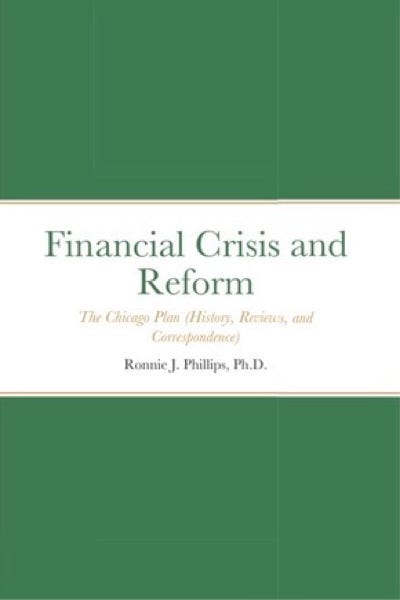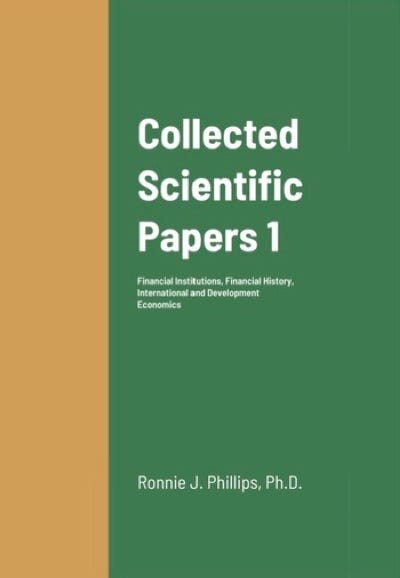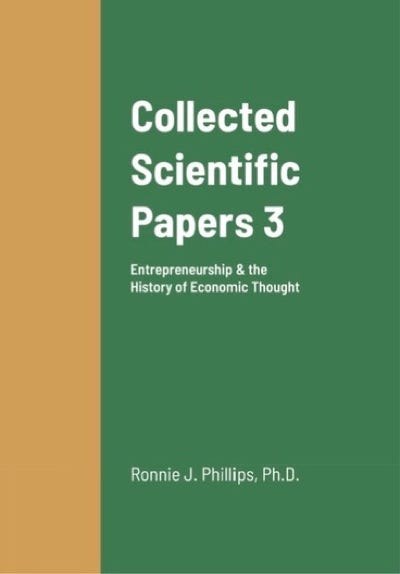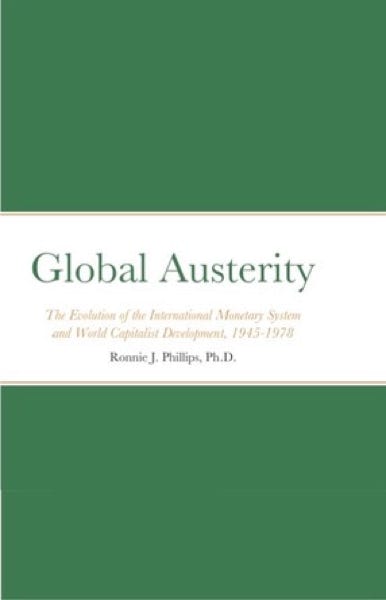Special editions now available.

Ronnie J. Phillips, Financial Crisis and Reform: The Chicago Plan (History, Reviews, and Correspondence), 2019. Includes book reviews and correspondence relating to the Chicago Plan for Banking Reform. 324pgs
Preface: The writing of The Chicago Plan for Banking Reform --Initial Interest in the 100% reserve proposal--The Levy Institute Project; Reviews of The Chicago Plan for Banking Reform Correspondence relating to The Chicago Plan for Banking Reform, Part I The Chicago Plan and New Deal Banking Reform, Part II Reviews of The Chicago Plan and New Deal Banking Reform, Part III Correspondence Relating to The Chicago Plan and New Deal Banking Reform (Includes correspondence with Milton Friedman, Lauchlin Currie, and others.)
This work presents a comprehensive history and evaluation of the role of the 100 percent reserve plan in the banking legislation of the New Deal reform era from its inception in 1933 to its re-emergence in the current financial reform debate in the US. Introduction; Chapter 1 A History of Currency and Banking in the United States; Chapter 2 Response to the Banking Crisis: Hoover, Congress, and the Economists; Chapter 3 Roosevelt’s Election and the Banking Crisis of 1933; Chapter 4 The March 1933 Chicago Memorandum; Chapter 5 The 100 Days Legislation and the Banking Act of 1933; Chapter 6 The November Chicago Memorandum; Chapter 7 The Banking Reform Agenda: A Federal Monetary Authority and Credit Allocation; Chapter 8 Currie, Eccles, and the Ideal Conditions for Monetary Control; Chapter 9 100% Money: Fisher’s Version of the Chicago Plan; Chapter 10 The Banking Act of 1935; Chapter 11 Academic Views of the Chicago Plan; Chapter 12 The Chicago Plan after the Passage of the Banking Act of 1935; Chapter 13 Financial Instability and Narrow Banking: Simons Revisited; Chapter 14 Conclusion;

Ronnie J. Phillips,Collected Scientific Papers Volume 1: Regulation of Financial Institutions, Financial History of the United States, International Economics, and Development Economics, 2017. 496pgs
1 Regulating Financial Markets: Assessing Neoclassical2 Regulating International Banking: Rationale, History, and Future Prospects 3 Regulating Derivatives in Banks: Lessons from the History of Financial Innovations 4 The New Institutional Structure of Banking: A Frame-work for Survival in the Digital Age 5 Federal Reserve Regulatory Authority Over Bank Holding Companies: An Historical Anomaly? 6 Supervision by Risk and Minsky’s Proposal for a Cash Flow-Oriented Bank Examination 7 Rethinking Bank Examinations: A Minsky Approach 8 Federal Housing Policies and the Recent Financial Crisis 9 The Federal Home Loan Bank System and the Farm Credit System: Historic Parallels and Implications for Systemic Risk 10 Underwriting in Property-Casualty Insurance Markets: Regulation, Risk and Volatility 11 Domestic Exchange Rates and Regional Economic Growth in the United States 1899-1908: Evidence from Cointegration Analysis 12 Par Clearance in the Domestic Exchanges: The Impact of National Bank Notes 13 Coping with Financial Catastrophe: The San Francisco Clearinghouse during the Earthquake of 1906 14 An End to Private Banking: Early New Deal Proposals to Alter the Role of the Federal Government in Credit Allocation 15 The Chicago Plan and the Reserve Increase of 1937 16 Safe Banking During the Great Depression: John M. Nichols, the FDIC and 100% Reserves 17 Why Are Bank Failures Special? 18 Digital Technology and Institutional Change from the Gilded Age to Modern Times: The Impact of the Telegraph and the Internet 19 Maxi-devaluations and Black Market Dollars in Wartime South Vietnam 20 ‘War News’ and Black Market Exchange Deviations from Purchasing Power Parity: Wartime South Vietnam 21 The Failure of Keynesianism and the Collapse of Bretton Woods 22 The Role of the International Monetary Fund in the Post-Bretton Woods Era 23 Latin America’s Debt Crisis, the International Monetary Fund, and Financial Reform 24 The European Monetary Payments System: Early Lessonsfrom the Federal Reserve and the Reichsbank 25 Economic Power, Financial Instability, and the Cuomo Report 26 The Internet Revolution, the “McLuhan” Stage of Catchup, and Institutional Reforms in Asia

Ronnie J. Phillips,Collected Scientific Papers Volume 2: Credit and Payments, 2017. 442pgs 1 Micro-credit 2 The Role of Morris Plan Lending Institutions in Expanding Consumer Microcredit in the United States3 Globalization and the Changing Relationship between Economic Development and Capital Markets: Innovations in Funding for Microfinance4 Community Development Banking: A Proposal to Establish a Nationwide System of Community Development Banks5 A Path to Community Development: The Community Reinvestment Act, Lending Discrimination, and the Role of Community Development Banks6 An Alternative in Small Business Finance: Community-Based Factoring Companies and Small Business Lending7 Small Business Lending in Colorado, 1995 to 19968 Credit Markets and Narrow Banking9 Strategic Pricing of Payday Loans: Evidence from Colorado, 2000-200510 Interest Rate Caps and Implicit Collusion: the Case of Payday Lending11 Payday Lending and Payments Services: A Historical and Modern Analysis12 Online Banking(2007)13 Online Banking (2009)14 Narrow Banking Reconsidered: The Functional Approach to Financial Reform 15 How to Avoid the Next Taxpayer Bailout of the Financial System: The Narrow Banking Proposal 16 A Look Back at the National Banking System and its Relevance for Today17 Correspondence Relating to The Chicago Plan and New Deal Banking Reform

Ronnie J. Phillips,Collected Scientific Papers Volume 3: Entrepreneurship and the History of Economic Thought, 2017. 338pgs
1 Entrepreneurship and Philanthropy in American Capitalism2 Non-market Sources of American Entrepreneurial Capitalism 3 Scientist Entrepreneurship: The Role of Policy 4 Introduction to E. E. Hale’s ‘Some Implications of Keynes’ General Theory of Employment, Interest, and Money’ 5 E. E. Hale on Economic Theory and the Real World 6 Radical Institutionalism and the Texas School of Economics’ 7 Is There a “Texas School”of Economics? 8 Introduction to Economic Mavericks: The Texas Institutionalists9 The Importance of Relative Prices in Analyzing Veblen Effects 10 Veblen and the“Wobblies”: A Note. 11 Persistence of the Veblenian “Old Japan”: Organizational Efficiency as a Wellspring of Competitiveness 12 Veblen and Simons on Credit and Monetary Reform 13 The Minsky—Simons—Veblen Connection: Comment . 14 Marx, the Classical Firm, and Economic Planning 15 The Twentieth Century Trend of Institutionalism in Mainstream Economics Journals 16 In Memoriam: Lloyd W. Mints 17 Bank Structure Conference Impact Study 18 The Wage System and The Divine Right of Capital 19 C. E. Ayres and the Strategy of Economic Progress 20 Bank Credit and Capital Formation: The Heretical Views of Harold Moulton and Adolf Berle

Ronnie J. Phillips,Daydream Believers: Essays on Entrepreneurs in Music, 2019. Writings on the music industry. 239pgs
We are in an era where developments in both technology and musical stylehave coalesced to produce the greatest period of change in the music industry since the invention of recorded sound. Globalization, the Internet, and digital technology are now opening up possibilities for more artists to be innovative and financially successful. But new music requires new ways of doing business. For more artists to be better off requires new business models to replace those that dominated the 20th century. Integrating insights from economics, management, and intellectual property law, the author explores the dynamics of entrepreneurship and innovation in the music industry. Preface 1 Daydream Believers: The Reality of Going from Garage Band to Superstardom 1.1 Prologue: Who Killed Buddy Holly? 1.2 Contents 1.3 So You Want to be a Rock and Roll Star? 1.4 Hitsville: Writing a Hit Song 1.5 Innovation: Will You Ever Hear Surf Music Again? 1.6 Contracts: You Never Give Me Your Money, All I Get Is Your Funny Paper 1.7 Live Performance: Touring Can Make You Crazy. Are Your Grandparents Driving Up Ticket Prices? 1.8 Death: Elvis Has Just Left the Building 1.9 The Technological Entrepreneurs: Engineers, Accountants,and Hippies 1.10 AbsolutelyFree: Only If You Want It to Be!1.11 Epilogue: Is Rock and Roll Here to Stay? 1.12 References, Song Index, and Subject Index 2 Breaking Up is Hard to Do: the Resilience of the Rock Group as an Organizational Form for Creating Music (with Ian C. Strachan) 3 The Long and Winding Road: Musicians on Tour from the Big Band Era to Rock and Roll

Ronnie J. Phillips,Global Austerity: The Evolution of the International Monetary System and World Capitalist Development: 1945-1978. Dissertation at The University of Texas at Austin, Economics Department, 1980. 370pgs The purpose of this dissertation is to provide an analysis of the evolution of the international monetary system in terms of the conflict between the strategies of the two fundamental classes in capitalist society: capitalist and working class. The methodological starting point is the work of Karl Marx, but the study draws upon recent work by Marxists critical of the mainstream of Marxist thought. The analysis of the international monetary system in the post-World War Two is divided into three time periods: 1945-1965, the functioning of the Bretton Woods agreement of 1944; 1966-1971, the breakdown of the system, and 1972-1978, the attempts at reform of the international monetary system.
The first period, 1945-1965, represents capital's initiative in response to working class struggles in the thirties and forties which forced capital to implement full employment and growth policies. Capital's strategy of national planning consisted of the use of monetary and fiscal policy to manipulate aggregate demand, the institutionalization through the union contract of a link between wage increases and productivity growth, and investment in "human capital". The functioning of the international monetary system was predicated on capital's successful implementation of "Keynesian" national planning.
In the late sixties, capital's strategy for full employment and growth was undermined globally by working class struggle. In the United States, for example, capital attempted to contain the struggle of the working class in Southeast Asia, while at the same time, meeting domestic working class demands for welfare, education, women's rights, minority rights, and so on. The struggles by factory workers increasingly undermined the "productivity deal" as workers demanded wages and benefits which exceeded productivity growth. The result for capital was a crisis in its command over labor-power and its ability to organize society. This set the stage for capital's global attack on the working class.
The opening rounds of capital's new initiative were fired on August 15, 1971 when Nixon suspended convertibility of the United States dollar and erected trade barriers, coupled with domestic wage and price controls. This was a direct response to the failure of the 1969-1970 recession to dampen wage demands. The next phase of capital's attack involved commodity inflation; a global depression, and finally the attempt to implement austerity to restore conditions favorable for accumulation. This dissertation examines this evolution and the changing power relations between the classes which result.
